
Flanders is the Dutch-speaking northern portion of Belgium and one of the communities, regions and language areas of Belgium. However, there are several overlapping definitions, including ones related to culture, language, politics, and history, and sometimes involving neighbouring countries. The demonym associated with Flanders is Fleming, while the corresponding adjective is Flemish, which can also refer to the collective of Dutch dialects spoken in that area, or more generally the Belgian variant of Standard Dutch.
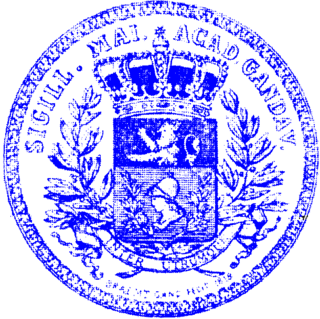
Ghent University is a public research university located in Ghent, Belgium.

The Flemish Movement is an umbrella term which encompasses various political groups in the Belgian region of Flanders and, less commonly, in French Flanders. Ideologically, it encompasses groups which have sought to promote Flemish culture and the Dutch language as well as those seeking greater political autonomy for Flanders within Belgium. It also encompasses nationalists who seek the secession of Flanders from Belgium, either through outright independence or (re)unification with the Netherlands.

Greater Netherlands is an irredentist concept which unites the Netherlands, Flanders, and sometimes Brussels. Additionally, a Greater Netherlands state may include the annexation of the French Westhoek, Suriname, formerly Dutch-speaking areas of Germany and France, or even the ethnically Dutch and/or Afrikaans-speaking parts of South Africa. A related proposal is the Pan-Netherlands concept, which includes Wallonia and potentially also Luxembourg.
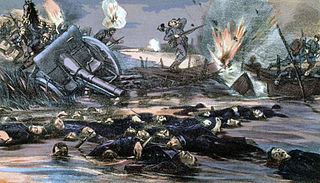
The Battle of the Yser was a battle of the First World War that took place in October 1914 between the towns of Nieuwpoort and Diksmuide, along a 35 km (22 mi) stretch of the Yser River and the Yperlee Canal, in Belgium. The front line was held by a large Belgian force, which halted the German advance in a costly defensive battle.

Moritz Ferdinand Freiherr von Bissing was a German officer from Prussia.

Wies Moens was a Belgian literary historian, poet and Flamingant activist. He was also a founding member of the right-wing Verdinaso movement.
The education in the Flemish Community covers the Dutch-speaking part of Belgium and consists of three networks (netten): government-provided education (gemeenschapsonderwijs), subsidized public schools and subsidized free schools.
Lodewijk De Raet was a Flemish economist and politician. He played an important role in the Flemish movement. He was co-founder of the Vlaamsche volkspartij (1892), and was a proponent of the use of Dutch instead of French at the University of Ghent in Flanders. He believed that the economic development of Flanders was necessary for the political and cultural strengthening of the region. His motto was: taalbelang is stoffelijk belang.

Louis Marie François Franck was a Belgian lawyer and liberal politician.
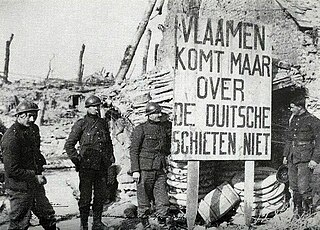
Flamenpolitik is a policy practiced by German authorities occupying Belgium during World War I and World War II. The ultimate goals of these policies was the dissolution of Belgium into separate Walloon and Flemish components and Germanisation.

The Duitsch-Vlaamsche Arbeidsgemeenschap, better known as DeVlag, was a small radical pro-Nazi organization active in Flanders during the German occupation of Belgium. It was founded in 1936 by academics Jef Van de Wiele and Rolf Wilkening as a cultural association to strengthen the exchange of students and professors between the universities of Leuven and Cologne.
The Frontpartij was a Belgian political party that campaigned for increasing recognition for the Flemish people and their language. Originating from the earlier Frontbeweging, the Frontpartij was an early attempt to fully politicise the Flemish Movement. In contrast to some of its successor movements the party supported democracy and autonomy rather than authoritarianism and independence.

The history of Belgium in World War I traces Belgium's role between the German invasion in 1914, through the continued military resistance and occupation of the territory by German forces to the armistice in 1918, as well as the role it played in the international war effort through its African colony and small force on the Eastern Front.

The Comité National de Secours et d'Alimentation was a relief organization created in 1914 to distribute humanitarian aid to civilians in German-occupied Belgium during World War I. It was directed by the Belgian financier Émile Francqui. The CNSA acted as the network by which the aid brought in by the international Commission for Relief in Belgium (CRB) could be distributed within Belgium itself.

The Yser Front, sometimes termed the West Flemish Front in British writing, was a section of the Western Front during World War I held by Belgian troops from October 1914 until 1918. The front ran along the Yser river (IJzer) and Yser Canal (Ieperlee) in the far north-west of Belgium and defended a small strip of the country which remained unoccupied. The front was established following the Battle of the Yser in October 1914, when the Belgian army succeeded in stopping the German advance after months of retreat and remained largely static for the duration of the war.

The Council of Flanders was formed by members of the "activist" or "maximalist" faction of the Flemish Movement in German-occupied Belgium on 4 February 1917 with tacit German support. Its founders, who included Pieter Tack and August Borms, wanted to realize the independence of Flanders from Belgium using German support provided as part of the Flamenpolitik. The Council originally included 46 members, but eventually expanded to include 93. Despite hopes that the council would be allowed full legislative powers, it never became more than a consultative body. It also suffered from internal factionalism and infighting.
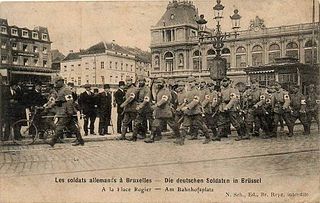
The German occupation of Belgium of World War I was a military occupation of Belgium by the forces of the German Empire between 1914 and 1918. Beginning in August 1914 with the invasion of neutral Belgium, the country was almost completely overrun by German troops before the winter of the same year as the Allied forces withdrew westwards. The Belgian government went into exile, while King Albert I and the Belgian Army continued to fight on a section of the Western Front. Under the German military, Belgium was divided into three separate administrative zones. The majority of the country fell within the General Government, a formal occupation administration ruled by a German general, while the others, closer to the front line, came under more repressive direct military rule.
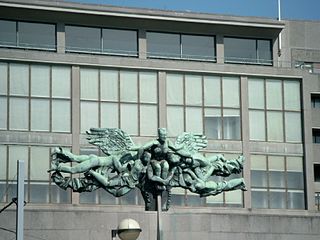
Jozef Cantré was a Belgian sculptor and illustrator. He was one of the main artists in the development of the movement of Flemish Expressionism.
The Flemish Guard was a collaborationist paramilitary formation which served as an auxiliary police in parts of German-occupied Belgium during World War II. It was founded as an independent formation in May 1941 at the initiative of the Union of Flemish Veterans and the Flemish National League. Both associated with the pre-war Flemish Movement, the VNV soon emerged as the largest collaborationist faction in Flanders during the occupation. In propaganda, the Flemish Guard was depicted as the police force of a future independent Flanders. It was distinct from the Flemish Legion, formed by the VNV in July 1941, to participate in the German invasion of the Soviet Union.


















